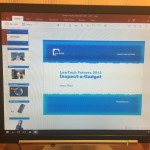I was going to write this post during the lock-down, when Zoom lived up to its name and took off in a big way. I had the idea of looking at Zoom vs Teams and why the former got such traction early on. But things changed week by week and much like the government guidance or the medias latest stick to bash them with, as soon as you think you have understood it things change again!
But during these past months I do seem to have used pretty much all the platforms rather than sticking to one specific one. Zoom, Teams, Skype for Business and Skype. And I can understand why Zoom became the to go to platform, it’s simplicity is its key. It’s stripped away all the complexity and focussed on the communications aspects, the video is done right – who’d have thought we wanted most to see everyone in the meeting not a constant slipping in and out of a big image of the speaker (or more likely see the person who is unmuted and crashing about) with a random 3 or 4 others in a small box or circle. Then add simple, but useful extra features like the ability to break out into small groups and top it off with an experience that most of the time just works and you’ve a winning formula.
There were some security concerns at the start, some valid and some I suspect stoked by competitors. But a number of updates seems to have addressed most of these (though I know some companies are still stopping use for reasons that have been patched weeks ago).
That was the original angle for the post, but Teams is now catching back up, by end of April they were talking about 3×3 video which was a welcome addition. By May breakout rooms were on the cards. Proving the benefit of the 365 platform, turning feature around quickly. So by the time we all get back to the offices there won’t be much feature wise to split Zoom and Teams for most firms.
I think though Zoom is here to stay and though. Teams will be a fixture for many, but I do think Microsoft missed a trick early on that could have removed the need for firms to also have Zoom. And it highlights that it really does need to sort out it’s mess of technologies and give a clear view of it’s platforms, let firms and consumers have a totally SaaS version of Teams without the need to configure a tenancy, that maybe is a stripped back version (but not separate!) to just communicate and have basic desktop sharing. Then bin Skype, both versions (look they ruined the consumer version, they had a killer cross platform solution, it was what Zoom was years ago but got ruined integrating in the Microsoft ID and all the other bloatware).
Simplicity of the Zoom offering will keep it in play, especially as it has got such a hold across the consumer space now (we’ve mentioned the Skype shambles, but Google and Facebook were late to this too and didn’t have their platforms ready to go). Personally during the lockdown Zoom has been the go to platform for pretty much every outside work situation my family has been in.
It’s hard to argue that home working has been a huge success, something that is now embedded and won’t shift backwards to the previous “normal”. But there are a couple of challenges left that need further work:
First the big challenge we will face going back to our offices, online conference calls have worked very well because everyone is remote. They still leave a lot to be desired though when the majority of attendees are in a physical meeting room. The remote workers start to get side-lined in this scenario.
As I mentioned in a talk just before the lockdown at the BLTF 2020, this is the area we need to start to develop and get right. The technology used to share video, presentations and whiteboards will need to be in every office collaboration area or spaces will need to be designated for hybrid meeting use and in person only meetings. There are so many scenarios we will all be familiar with of being unable to connect visitors, having the wrong video connection etc We will need to solve these quickly as we are not going to get rid of home working now!
Second challenge is another I raised at that presentation. Voice quality. Thankfully in work situations we have developed the etiquette of using good quality microphones (usually headsets or quiet rooms and a good PC/Mac mic), muting yourself when not speaking and the host managing the meeting to keep the background noise down. Even with all the childcare challenges people have had this discipline has meant meetings have run extremely well. I can’t say the same for the outside meetings though, the difference is noticeable (“unmutees”, “camera fiddlers” and “upnosers”) and this will unfortunately be the same when we’re having the hybrid office & remote meetings.
One ray of hope though is work companies like nVidia have been doing to utilise spare capacity in their graphics cards to run AI technology to eliminate background noise. Could this be the audio equivalent of the background blur in video?? Watch the video on the BBC site, the results are pretty amazing! And it’s early days too so to see that companies are starting to see the challenge and doing work to develop this area is great news.
It’s clear that after this situation we are in is over things will be different. I hate the term “new normal” as I don’t things will be revolutionary different, we’ll quickly slip back to a recognisable normal (it’s already underway) but we will embrace remote working as it works (as a lot of us who were doing it previously knew anyway). So it’ll be more an acceleration of what was already happening. What we will need is the same acceleration in the tech at the office end when we start to go back in.



















